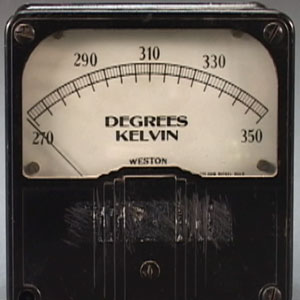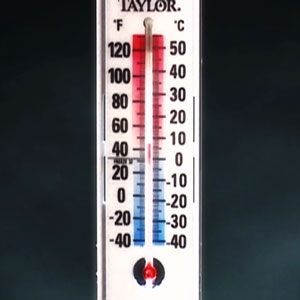Join us for conversations that inspire, recognize, and encourage innovation and best practices in the education profession.
Available on Apple Podcasts, Spotify, Google Podcasts, and more.
Look for the following topics in the video, indicated by the ![]() onscreen icon, and click below to learn more.
onscreen icon, and click below to learn more.
 Three Scales of Temperature |
 Why do We Need Heated Towel Racks? |

Thermometer showing the Fahrenheit
and Celsius scales.
As mentioned in the video, the two scales we are most familiar with, the Fahrenheit and Celsius (also known as centigrade) scales, are defined in terms of events that are universal: a temperature of zero on the Fahrenheit scale is the temperature of a mixture of equal parts ice, water, and salt, and the freezing point of water is what sets the zero point on the Celsius scale. A difference of one degree Celsius is larger than a difference of one degree Fahrenheit.
So why do we need yet another temperature scale?
If we examine the definition of temperature as it relates to our particle model, we can see that there is something more fundamental on which to base our temperature scale. Temperature is related to the average energy of the motion of the particles of the object. Therefore, a natural point for a temperature scale is the point at which all particle motion stops. This point is defined as zero on the Kelvin scale. The unit of the Kelvin scale is referred to as a “Kelvin,” and the magnitude of one Kelvin is the same as the magnitude of one degree Celsius. The zero temperature on the Kelvin scale is called absolute zero.
Is it possible to reach absolute zero?

Thermometer using the Kelvin scale.
In a word, no. As we’ve seen in previous sessions, successful scientific models often break down when they are applied to circumstances with extreme conditions: for example, mass conservation breaks down when we deal with the high temperatures and pressures inside a star. Very low temperatures are another extreme. As it turns out, the best model for understanding the world of the very small, quantum mechanics, dictates that we cannot completely stop the motion of any particles, no matter how hard we try. However, with certain special techniques (including using the light from lasers to slow down particles), scientists have been able to lower the temperature of matter to just a fraction of a Kelvin above absolute zero.
At these very low temperatures, matter behaves very differently than it does near room temperature. As a result, scientists had to develop further refinements to their particle model. However, since everyday life is experienced between the extremes of high and low temperatures, we do not observe or experience any of these unusual effects.
In this video, weather forecaster Bill Babcock tells us that, when we step out of the shower, it takes energy from our skin to turn liquid water into water vapor via evaporation. To understand this process better, let’s take a closer look at what happens at the microscopic level.
 Recall that earlier in the session we looked at what happens when energy is transferred as heat from a hot mug of tea to your hand:
Recall that earlier in the session we looked at what happens when energy is transferred as heat from a hot mug of tea to your hand:
Essentially, the process we are about to describe is the reverse of that process: heat flows from your skin to the water.
In both your skin and the water on your skin, the particles are moving with a distribution of speeds (i.e., some move faster than others) but the average energy of their motion is related to the temperature of your skin and the temperature of the water. However, the particles in the water that are moving faster than average may be moving fast enough to overcome the pull they feel from their neighbors and break away from the surface of the liquid water into the air. By doing this, the remaining water is at a lower temperature because the average energy of motion of all the particles has gone down. See the side illustration for clarification.
Since there is now a temperature difference between your skin and the water on it, heat flows to the water. On a microscopic level, your skin particles collide with the water molecules, transferring some energy of motion. As a result, the water molecules move faster and your skin particles move slower. This leaves the temperature of your skin lower and you feel colder, while the temperature of the water goes up and the faster-moving molecules escape. The process keeps repeating until all the water is gone. This is why it doesn’t feel as cold if you towel off quickly.
This same process happens at the surface of any liquid that is evaporating. Try observing what happens in the microscopic world when heat is transferred in the Session 3 Virtual Particle Lab.